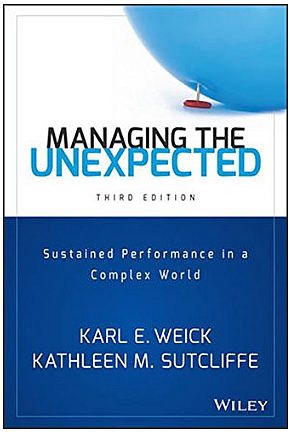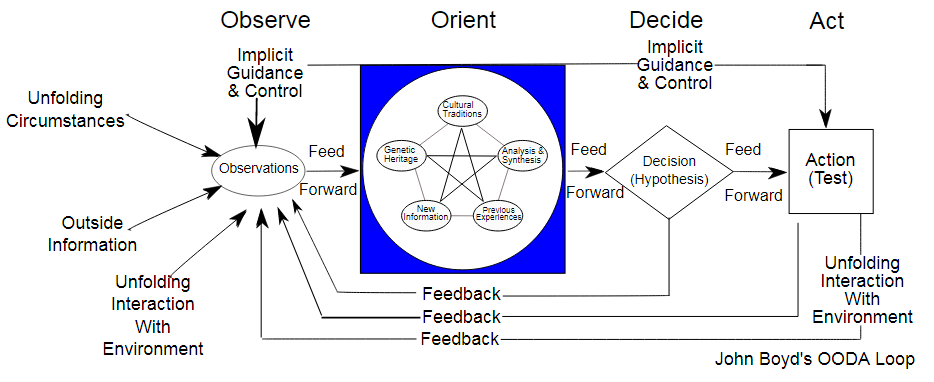OODA is something we all do thousands of times a day without noticing.
Observe – Orient – Decide – Act.
The term is attributed to Colonel John Boyd, a real world “Top Gun” who studied economics and engineering, then flew and designed fighter planes, then became a well-respected military strategist.
OODA is a continuous process of updating our mental model based on sensed evidence.
And it is a fast process because happens largely out of awareness.
This was Boyd’s point: In military terms, the protagonist that can make wiser and faster decisions are more likely to survive in combat.
And notice that it is not a simple linear sequence … it is a system … there are parallel paths and both feed-forward and feed-backward loops … there are multiple information flow paths.
And notice that the Implicit Guidance & Control links do not go through Decision – this means they operate out of awareness and are much faster.
And notice the Feed Forward links link the OODA steps – this is the conscious, sequential, future looking process that we know by another name:
Study-Adjust-Plan-Do.
We use the same process in medicine: first we study the patient and the problem they are presenting (history, examination, investigation), then we adjust our generic mental model of how the body works to the specific patient (diagnosis), then we plan and decide a course of action to achieve the intended outcome, and then we act, we do it (treatment).
But at any point we can jump back to an earlier step and we can jump forwards to a later one. The observe, orient, decide, act modes are running in parallel.
And the more experience we have of similar problems the faster we can complete the OODA (or SAPD) work because we learn what is the most useful information to attend to, and we learn how to interpret it.
We learn the patterns and what to look for – and that speeds up the process – a lot!
This emergent learning is then re-inforced if the impact of our action matches our intent and prediction and our conscious learning is then internalised as unconscious “rules of thumb” called heuristics.
We start by thinking our way consciously and slowly … and … we finish by feeling our way unconsciously and quickly.
Until … we encounter a novel problem that does not fit any of our learned pattern matching neural templates. When that happens, our unconscious, parallel processing, pattern-matching system alerts us with a feeling of confusion and bewilderment – and we freeze (often with fright!)
Now we have a choice: We can retreat to using familiar, learned, reactive, knee-jerk patterns of behaviour (presumably in the hope that they will work) or we can switch into a conscious learning loop and start experimenting with novel ideas.
If we start at Hypothesis then we have the Plan-Do-Study-Act cycle; where we generate novel hypotheses to explain the unexpected, and we then plan experiments to test our hypotheses; and we then study the outcome of the experiments and we then we act on our conclusions.
 This mindful mode of thinking is well described in the book “Managing the Unexpected” by Weick and Sutcliffe and is the behaviour that underpins the success of HROs – High Reliability Organisations.
This mindful mode of thinking is well described in the book “Managing the Unexpected” by Weick and Sutcliffe and is the behaviour that underpins the success of HROs – High Reliability Organisations.
The image is of the latest (3rd edition) but the previous (2nd edition) is also worth reading.
So we have two interdependent problem solving modes – the parallel OODA system and the sequential SAPD process.
And we can switch between them depending on the context.
Which is an effective long-term survival strategy because the more we embrace the unexpected, the more opportunities we will have to switch into exploration mode and learn new patterns; and the more patterns we recognise the more efficient and effective our unconscious decision-making process will become.
This complex adaptive system behaviour has another name … Resilience.


